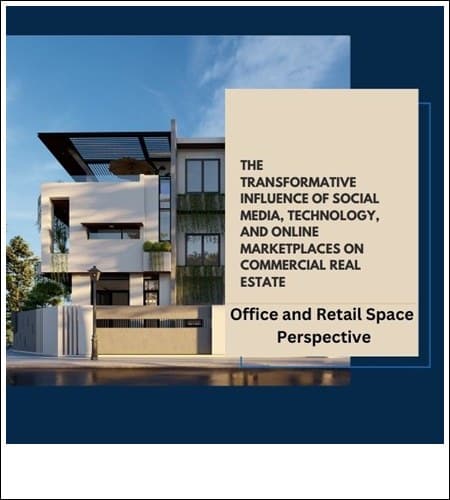
In an age dominated by the internet, technology, and social media, the impact of these forces extends far beyond personal interactions and entertainment. Commercial real estate, particularly office and retail space, has also experienced significant transformations due to these digital advancements. This article explores the intersection of social media, technology, online marketplaces, and commercial real estate, highlighting how these factors have reshaped the industry and revolutionized how office and retail spaces are marketed, leased, and utilized.
The Influence of Social Media and Online Marketplaces on Commercial Real Estate
Social media platforms have evolved as practical tools for engaging with potential clients, growing networks, and advertising offices and retail premises. Platforms like LinkedIn, Twitter, and Facebook give industry experts unprecedented access to a large audience, allowing them to exhibit listings, share insights, and engage in meaningful conversations. Furthermore, the ability of social media to provide customized advertising campaigns guarantees that office and retail spaces reach the appropriate audience, optimizing visibility and increasing the possibility of successful transactions.
The rise of online marketplaces and platforms dedicated to commercial real estate, such as MyElisting.com, has further revolutionized the industry. These platforms serve as a central focus for property searches, removing the need for lengthy manual investigations. Professionals can gain access to extensive information about available office and retail spaces, such as cost, square footage, location, and amenities, allowing potential tenants and buyers to make well-informed judgments. Online marketplaces have democratized information access, creating a more transparent and efficient office and retail space market.
Technological Advancements Reshaping Office and Retail Space
Technology has changed how people use and interact with office and retail facilities. Potential tenants and buyers can now explore homes remotely, experiencing immersive virtual tours that provide a genuine sense of space, layout, and architecture, thanks to the advancement of virtual reality (VR) and augmented reality (AR). This technology improves decision-making by allowing stakeholders to assess the viability of office and retail spaces without physically visiting each place.
Technological advancements like big data and analytics have also enabled data-driven decision-making within the commercial real estate sector. Real estate companies can leverage data insights to identify market trends, assess property performance, and forecast future demand. This enables more informed investment decisions, optimized space utilization, and targeted marketing strategies for office and retail spaces. Furthermore, integrating intelligent building technologies allows for enhanced energy efficiency, improved security, and optimized operations in commercial properties.
The Changing Landscape of Office and Retail Space
The advent of remote work and e-commerce has profoundly influenced the demand for and usage of office and retail locations. The COVID-19 epidemic has increased the acceptance of remote work, causing businesses to reconsider their office space requirements. Many organizations have adopted flexible work arrangements, resulting in a shift in office space needs. As a result, the notion of coworking spaces and flexible office solutions has gained traction, providing businesses with the flexibility to react to shifting worker dynamics.
In retail, e-commerce has disrupted traditional brick-and-mortar retail, emphasizing the importance of integrating digital strategies into physical stores. As a result, retailers increasingly use technology to enhance the in-store experience, incorporating features like augmented reality, mobile payments, and personalized recommendations. Moreover, social media and online marketplaces have become crucial for retailers to showcase their products, engage with customers, and drive foot traffic to their physical stores.
Conclusion
Finally, social media, technology, online markets, and commercial real estate convergence have transformed the office and retail space industries. Professionals and firms that embrace these digital innovations have acquired a competitive advantage by promoting, leasing, and utilizing premises more efficiently. As technology evolves, it will be critical for industry participants to adapt and embrace these changes to stay competitive in an ever more digital and connected world. The commercial real estate sector can develop more flexible, sustainable, and busy office and retail facilities that match the needs of the modern world by leveraging the power of cutting-edge technology, online markets, and social media.
Leave a Reply
You must be logged in to post a comment.